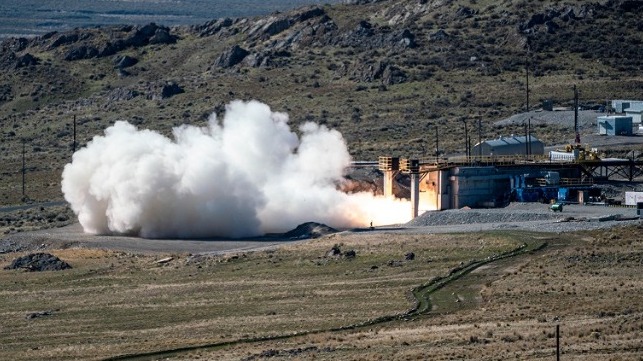To Counter China, U.S. Navy Ramps Up Testing for Hypersonic Missile

The U.S. Navy's new hypersonic rocket is moving closer to flight testing as the service works to speed up its deployment. Last week, in collaboration with the U.S. Army, the navy conducted a static fire test of the first stage of its newly developed 34.5” common hypersonic missile, which will be fielded by both services.
The live fire test follows previous trials of the rocket's first and second stages in May and August. The static fire test marked the first time that the first stage rocket included a thrust vector control system, used for maneuvering in flight.
"We are on schedule for the upcoming flight test of the full common hypersonic missile. Our partners across government, industry, and academia are continuing the excellent work that is essential to providing a hypersonic capability to our warfighters as quickly as possible," said Vice Adm. Johnny R. Wolfe Jr, Director, Navy's Strategic Systems Programs, the lead designer for the program.
Hypersonic weapons are capable of flying at speeds greater than five times the speed of sound, are highly maneuverable and operate at varying altitudes. This makes them far more difficult to intercept with a missile defense system.
Russia and China are rapidly weaponizing and fielding hypersonic capabilities, giving them an advantage "that must be addressed," the Navy said in a statement. Russia put a nuclear-capable hypersonic glide body into service on an ICBM in 2019, and the People's Liberation Army deployed both a hypersonic anti-ship cruise missile and a hypersonic glide body in 2019. China has begun testing a hypersonic glide body designed for "fractional orbital bombardment," a trajectory that orbits the Earth the long way around in order to reach the target from an unexpected direction.

that matters most
Get the latest maritime news delivered to your inbox daily.
The service's tests are part of its efforts to develop a Navy-designed common hypersonic missile that both the Navy and Army will field. The missile consists of the first stage rocket (part of a new submarine-compatible missile booster) combined with the Common Hypersonic Glide Body (CHGB), a maneuverable reentry vehicle that can travel long horizontal distances at extreme speed.
“This test continues to build momentum to deliver hypersonics capability for our warfighters in support of the National Defense Strategy,'' said LTG L. Neil Thurgood, Director of Hypersonics, Directed Energy, Space and Rapid Acquisition. "Fielding hypersonic weapons is one of the highest priority modernization areas the Department of Defense is pursuing to ensure our continued battlefield dominance, and the joint team did a tremendous job executing this test and keeping us on schedule.”
